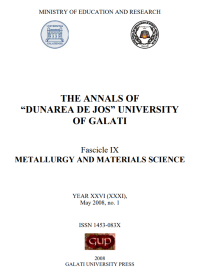Fatigue Degradation of Materials as a Tool for Damage Assessment
Abstract
Damage assessment of components or systems is strongly related to the way components fail. Thus, an appropriate understanding of failure degradation of components is necessary. Furthermore, most of the failures are related to fatigue cracks that develop on components under service. This paper is concerned with the fatigue degradation of metallic components. Its emphasis is on the different ways in which the fatigue damaging mechanisms occur, being the main responsible for the failure of components.
This paper has two main sections: one section deals with the fatigue mechanisms and their definition; the second section focuses on the failure analysis of components affected by those mechanisms.
Downloads
References
[2]. Fuchs, H. O., Stephens, R. I. 1980, "Metal fatigue in engineering” John Wiley & Sons, p. 2.
[3]. Heyes, A. M.-1998, “Automotive Component Failures”, Engineering Failure Analysis, vol. 4, no. 1, p. 129-141.
[4]. Fernandes, P. J. L. 1996, “Tooth Bending Fatigue Failures in Gears”, Engineering Failure Analysis, vol. 3, no. 3, p. 219-225.
[5]. Mackin, T.J., et al, 2002, “-Thermal Cracking in Disk Brakes”, Engineering Failure Analysis, vol. 9, p. 63-76.
[6]. Liu X.W., Plumbridge, W.J., 2003, “Thermomechanical fatigue of Sn–37 wt.% Pb model solder joints”, Materials Science and Engineering A362, p. 309-321.
[7]. Silva, F.S, 2006, "Fatigue on engine pistons – A compendium of case studies” V.13, p. 480-492.
[8]. Klaus R., Tilmann B., Detlef L., 2003, “Isothermal, thermal_/mechanical and complex thermal_/mechanical fatigue tests on AISI 316 L steel*/a critical evaluation”, Materials Science and Engineering, A345, p. 309-318.
[9]. Liu F. , Ai S.H., Wang Y.C., Zhang H., Wang Z.G., 2002, “Thermal-mechanical fatigue behavior of a cast K417 nickel-based superalloy”, International Journal of Fatigue, 24, p. 841-846.
[10]. Luo J., Dong H., Bell T., 2006, “Model-based contact fatigue design of surface engineered titanium gears”, Computational Materials Science 35, p. 447-457.
[11]. Maekawa, I., 2005, “The influence of stress wave on the impact fracture strength of cracked member”, International Journal of Impact Engineering 32, p. 351-357.
[12]. Zhang M., Yang P., Tana Y., Liu Y., Gong S., 1999, “An observation of crack initiation and early crack growth under impact fatigue loading”, Materials Science and Engineering A271, p. 390-394.
[13]. Osman, A., 2006, “Failure of a diesel engine injector nozzle by cavitation damage”, Engineering Failure Analysis, 13, 7, p. 1126-1133.
[14]. Zhang Y., Wang, Z., Cui, Y., 2000, “The cavitation behavior of a metastable Cr–Mn–Ni Steel”, Wear 240, p. 231-234.
[15]. Webster, G.A., Ainworth, R.A., 1994, “High Temperature Component Life Assessment”, Chapman & Hall.
[16]. Aktaa, J., Schmitt, R., 2006, “High temperature deformation and damage behavior of RAFM steels under low cycle fatigue loading: Experiments and modelling” Fusion Engineering and Design, in press.
[17]. Silva, F.S., 2003, "Analysis of a vehicle crankshaft failure”, Engineering Failure Analysis, Pergamon, V.10, N5, October p. 605-616.
[18]. Llanes, L., Torres, Y., Anglada, M., 2002, “On the fatigue crack growth behavior of WC–Co cemented carbides: kinetics description, microstructural effects and fatigue sensitivity” Acta Materialia 50, p. 2381-2393.
[19]. Hoeppner D. W., 2006, “Fretting fatigue case studies of engineering components” Tribology International, in press.
[20]. Xuan S., Yaowu S., 2003, “Corrosion fatigue cracking of tube coils in an actifier column catalytic cracker”, Engineering Failure Analysis 10, p. 297-306.
[21]. Lynch, S.P., 2003, “Failures of Engineering Components Due to Environmentally Assisted Cracking”, ASM International, 5, p. 33-42.
[22]. Mota, V.M.M.B., Moreira, P.M.G.P., Ferreira, L.A.A., 2006, “Stress Intensity Factor Calculation for Inclined SurfaceBreaking Cracks Initiated in an Artificial Indentation Under Rolling Contact Fatigue Using the Edge Green Functions”, 10th Portuguese Conf. on Fracture.



